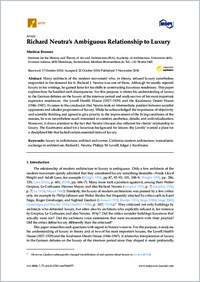Richard Neutra’s ambiguous relationship to luxury
- Brunner, Matthias Institute for the History and Theory of Art and Architecture (ISA), Academy of Architecture, Università della Svizzera italiana, Switzerland
-
05.11.2018
Published in:
- Arts. - 2018, vol. 7, no. 4, p. 75
Luxury in architecture
Architect and owner
California modern architecture
Transatlantic exchange in architecture
Richard J. Neutra
Philipp M. Lovell
Edgar J. Kaufmann
English
Many architects of the modern movement who, in theory, refused luxury nonetheless responded to the demand for it. Richard J. Neutra was one of them: Although he mostly rejected luxury in his writings, he gained fame for his skills in constructing luxurious residences. This paper explores how he handled such discrepancies. For this purpose, it relates his understanding of luxury to the German debates on the luxury of the interwar period and analyzes two of his most important expensive residences: the Lovell Health House (1927–1929) and the Kaufmann Desert House (1946–1947). It comes to the conclusion that Neutra took an intermediate position between socialist opponents and idealist proponents of luxury. While he acknowledged the importance of objectivity and scientific thinking and agreed to give priority to the improvement of the living conditions of the masses, he was nevertheless much interested in comfort, aesthetics, details, and individualization. Moreover, it draws attention to the fact that Neutra’s houses also reflected his clients’ relationship to luxury. The Kaufmanns asked for a luxurious background for leisure; the Lovells’ wanted a place for a disciplined life that lacked certain essential traits of luxury.
- Language
-
- English
- Classification
- Architecture
- License
- Open access status
- gold
- Identifiers
-
- RERO DOC 328303
- DOI 10.3390/arts7040075
- ARK ark:/12658/srd1319079
- Persistent URL
- https://n2t.net/ark:/12658/srd1319079
Statistics
Document views: 173
File downloads:
- Texte intégral: 233
